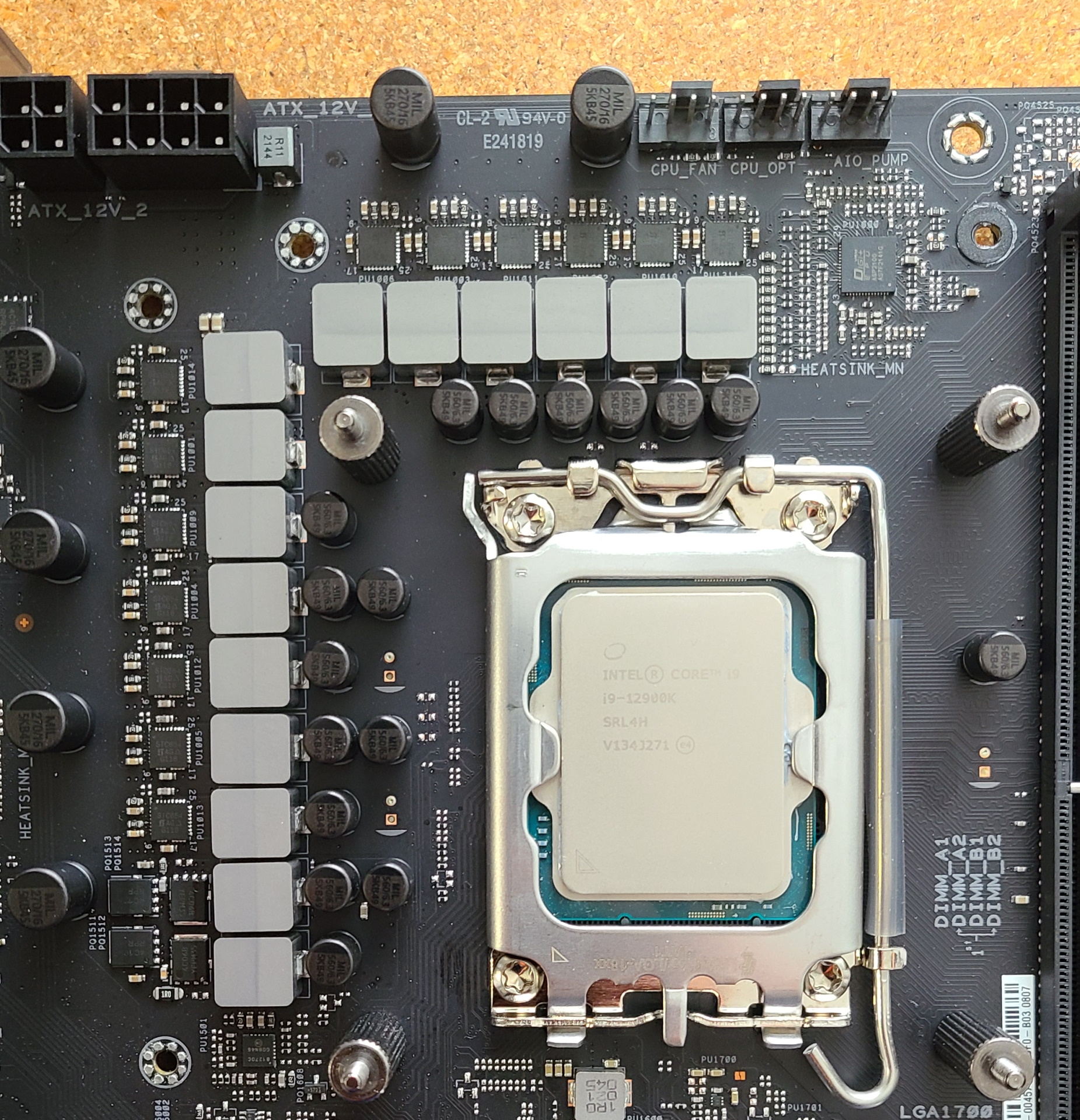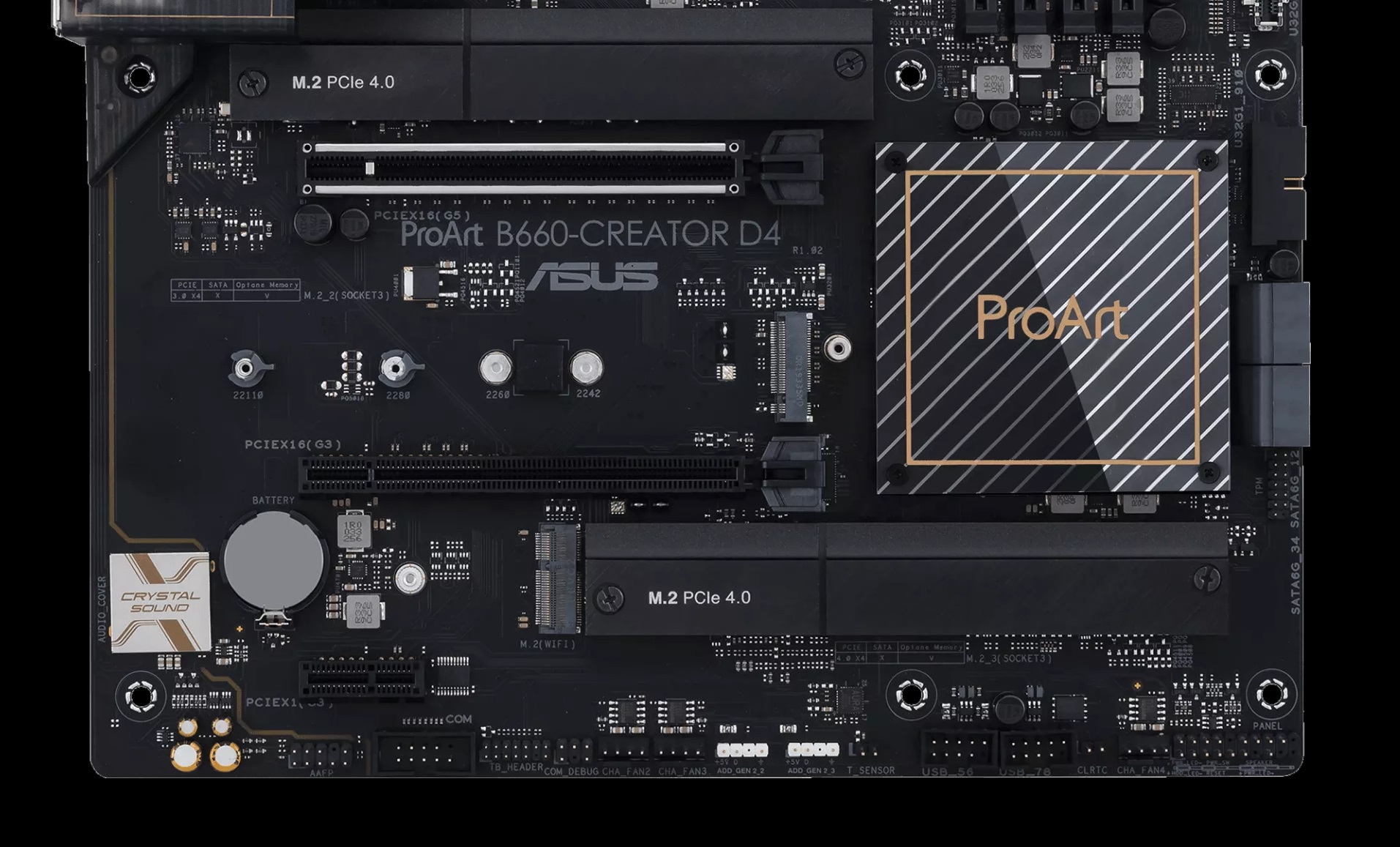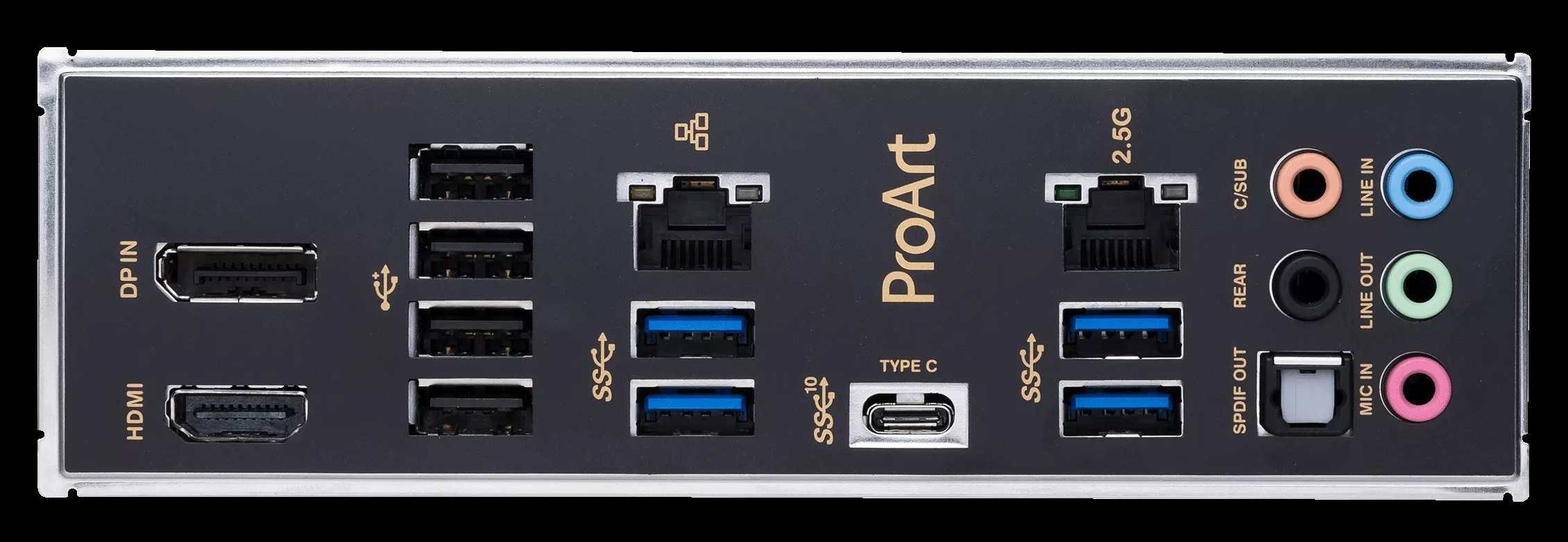Tom's Hardware Verdict
Priced under $200, Asus’ B660-Creator D4 is a solid budget board for creative professionals. It may not have all the bells and whistles of the Z690 version, but it’s less than half the pricef. If you’re looking to use the flexibility of the USB Type-C display option and don’t need integrated Thunderbolt 4 (40 Gbps) ports, this board should be on your shortlist.
Pros
- +
Budget ATX-size ‘professional’ board
- +
Plenty of USB ports
- +
USB Type-C DisplayPort capability
Cons
- -
Slower multi-threaded performance
- -
No M.2 SATA support
Why you can trust Tom's Hardware
If you’re a creative professional looking to build your own Alder Lake PC and not break the bank doing so, the Asus ProArt B660-Creator D4 is here to satisfy your needs. Priced under $200, the board offers a professional appearance (no RGBs!) and the connectivity you’d expect for a budget-minded creator board. You get three M.2 sockets, a Thunderbolt header support, dual ethernet ports and even USB-C DisplayPort for connecting a monitor. In all, this is one of the least expensive ATX ‘pro’ series boards available.
Other boards around the same price are just as capable, but are focused more on general use and gaming, so you lose some of the flexibility the Pro board offers (DisplayPort USB-C and Thunderbolt header support, for example). Connectivity aside, the black-on-black board with gold accents/branding doesn’t stick out (no RGB LEDs) like a lot of these gaming boards, but is intended for a professional who may not want gowing bling out of the box in the first place.
Performance on the ProArt was average overall, with some heavily multi-threaded benchmarks running a little slower than most other DDR4-based motherboards. The Procyon Office benchmark was the bright point, and gaming performance was solid too. While a decent performer, at default settings, the processor throttles in heavily multi-threaded situations due to high temperatures. In order to get the most out of your mighty Intel Core i9-12900K, you may have to use a voltage offset to prevent the processor from throttling.
Below, we’ll dig into all the details to see if this budget creator board earns a spot on our best motherboards list. But before we do, here’s a list of specifications for the ProArt B660-Creator D4 from the Asus website.
Specifications: Asus ProArt B660-Creator D4
| Socket | LGA1700 |
| Chipset | B660 |
| Form Factor | ATX |
| Voltage Regulator | 13 Phase (12x 50A MOSFETs for Vcore) |
| Video Ports | (1) HDMI (v2.1) |
| Row 5 - Cell 0 | (1) DisplayPort (v1.4) Input |
| Row 6 - Cell 0 | (1) USB Type-C (DisplayPort output) |
| USB Ports | (1) USB 3.2 Gen 2 Type-C (10 Gbps) |
| Row 8 - Cell 0 | (4) USB 3.2 Gen 1 (5 Gbps) |
| Row 9 - Cell 0 | (4) USB 2.0 (480 Mbps) |
| Network Jacks | (1) 2.5 GbE |
| Row 11 - Cell 0 | (1) GbE |
| Audio Jacks | (5) Analog + SPDIF |
| Legacy Ports/Jacks | ✗ |
| Other Ports/Jack | ✗ |
| PCIe x16 | (1) v5.0 (x16) |
| Row 16 - Cell 0 | (1) v3.0 (x4) |
| PCIe x8 | ✗ |
| PCIe x4 | ✗ |
| PCIe x1 | (1) v3.0 (x1) |
| CrossFire/SLI | ✗ |
| DIMM Slots | (4) DDR4 5333+(OC), 128GB Capacity |
| M.2 Sockets | (1) PCIe 4.0 x4 (64 Gbps) / PCIe (up to 110mm) |
| Row 23 - Cell 0 | (1) PCIe 3.0 x4 (32 Gbps) / PCIe + SATA (up to 80mm) |
| Row 24 - Cell 0 | (1) PCIe 4.0 x4 (64 Gbps) / PCIe (up to 110mm) |
| U.2 Ports | ✗ |
| SATA Ports | (4) SATA3 6 Gbps (Supports RAID 0/1/5/10) |
| USB Headers | (1) USB v3.2 Gen 2x2, Type-C (20 Gbps, 60W) |
| Row 28 - Cell 0 | (1) USB v3.2 Gen 1 (5 Gbps) |
| Row 29 - Cell 0 | (2) USB v2.0 (480 Mbps) |
| Fan/Pump Headers | (7) 4-Pin (CPU, CPU OPT, AIO Pump, Chassis fans) |
| RGB Headers | (3) aRGB (3-pin) |
| Row 32 - Cell 0 | (1) AURA RGB (4-pin) |
| Diagnostics Panel | EZ Debug LED |
| Internal Button/Switch | ✗ |
| SATA Controllers | ✗ |
| Ethernet Controller(s) | Realtek RTL8125BG (2.5 Gbps) |
| Row 37 - Cell 0 | Intel I219-V (GbE) |
| Wi-Fi / Bluetooth | ✗ |
| USB Controllers | ✗ |
| HD Audio Codec | Realtek ALC897 |
| DDL/DTS Connect | ✗ / X |
| Warranty | 3 Years |
Inside the Box of the Asus ProArt B660-Creator D4
Inside the box, Asus encloses several accessories along with the board. The contents are standard for a budget board and comes with the basics to get you started, including a driver disk, SATA cables, an M.2 screws, and more. Below is a complete list of the included extras.
- DisplayPort cable
- (2) SATA cables
- (3) M.2 rubber packages
- (1) M.2 screw package
- Q-Connector
- Support DVD
- User guide
- Express Activation key card
Design of the B660-Creator D4
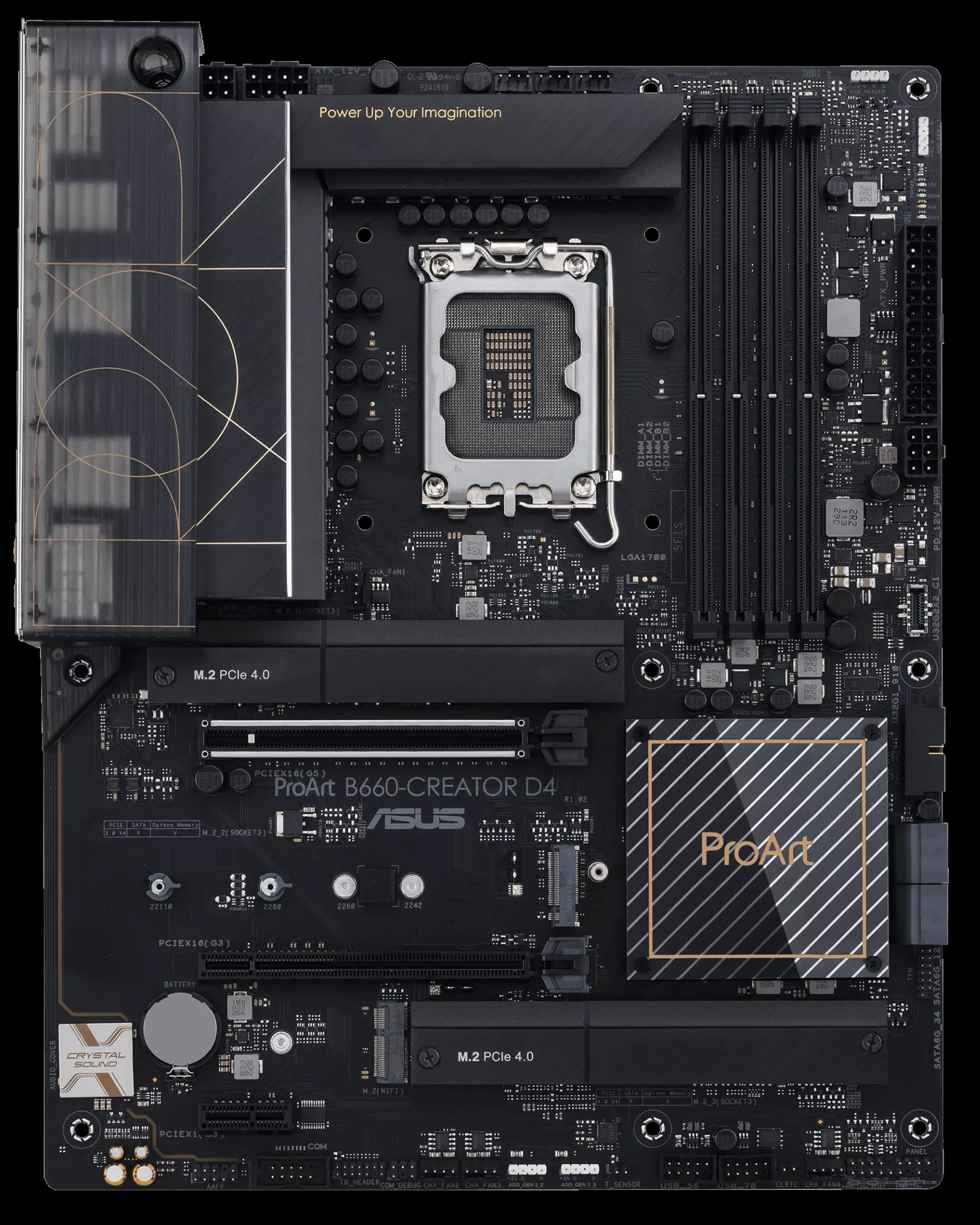
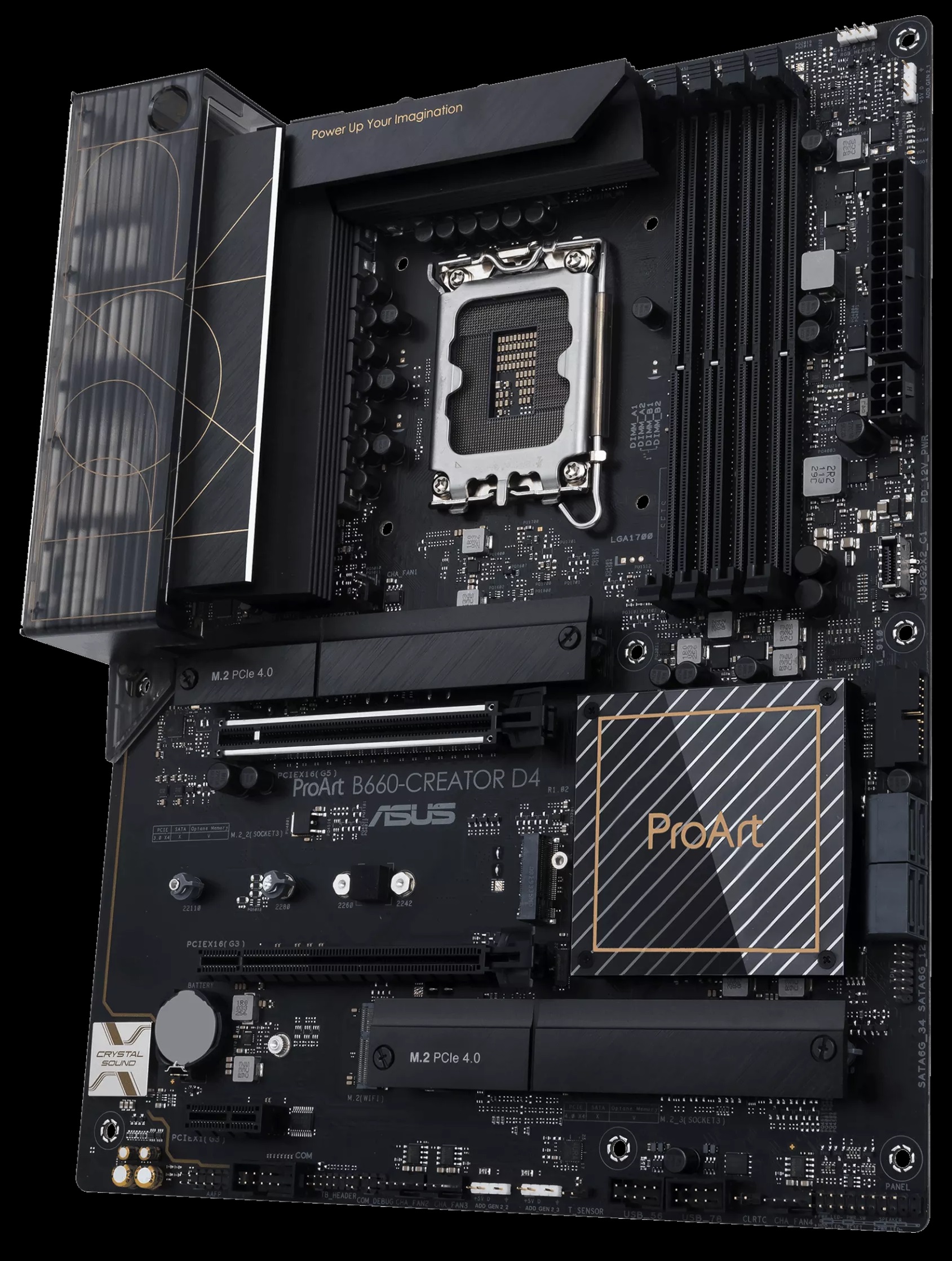
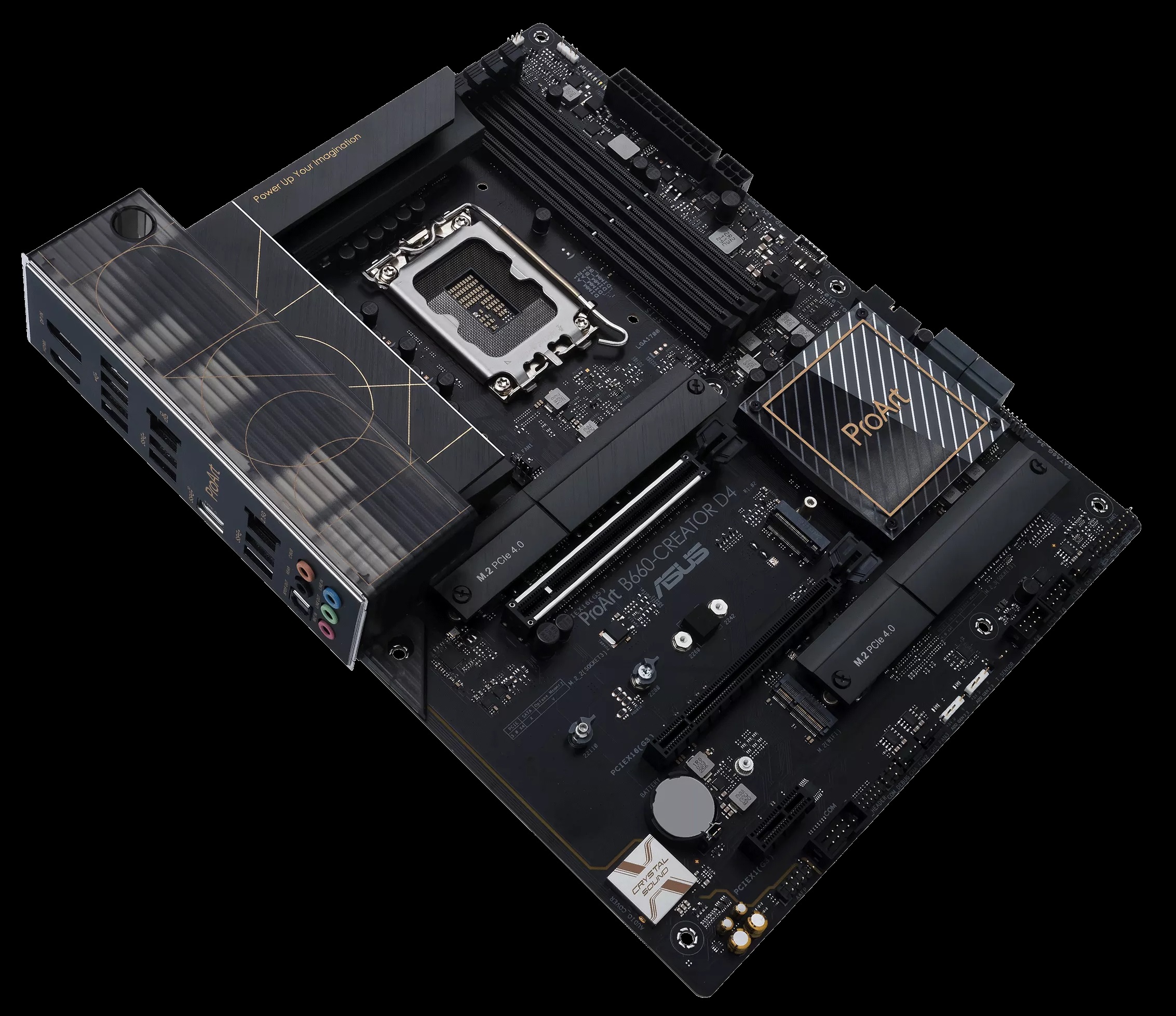
Designed for creative professionals, the ProArt Series, according to Asus, focuses on reliability and flexibility compared to most other boards. Where you get an RGB light show on some boards, the ProArt series looks more at what creatives need for their workflows. The all-black board sports the ProArt name artfully placed on the large VRM heatsink and the plastic shroud covering it. The chipset heatsink is a large square with additional ProArt branding. The slots and sockets are also black, outside of the primary PCIe slot with its EMI protection (silver) surrounding it. The board won’t bring attention to itself, but if you’d like to add RGBs, you certainly can.
Starting on the left side of the board, we see a plastic shroud with a translucent smoke finish covering the rear IO bits and part of the VRM heatsink. Both VRM heatsinks contain plenty of mass and surface area to cool effectively. Just above the left VRM bank are 4-pin and 8-pin EPS connectors to power the processor.
Get Tom's Hardware's best news and in-depth reviews, straight to your inbox.
Along the top edge, in the middle, are three (of seven) 4-pin fan headers (CPU_FAN/OPT, AIO_PUMP). All fan headers are Q-fan controlled through the BIOS or Asus software. The CPU headers automatically detect if the attached device is PWM or DC controlled; the rest require a manual adjustment. All headers output up to 1A/12W. While this is good for fans and most AIOs, it may not be enough for a high-powered pump in a custom water cooling loop. But again, that’s not the kind of rig this board was designed for.
Off to the right of the LGA1700 socket are four unreinforced DRAM slots that lock at the top. Asus lists support for DDR5-5333+(OC) and a capacity of 128GB. We didn’t run into any issues with either of the kits we used to test.
In the right corner are two (of four) RGB headers. In this location is a 4-pin RGB and 3-pin ARGB headers with two more ARGB headers along the bottom. Continuing down the right edge, we first run into the Q-LEDs that check key components (CPU, DRAM, VGA, and Booting devices) during the POST process. Next, a 24-pin ATX for board power and a 6-pin PCIe connector for the supported PD 3.0/QC 4.0+ fast charging technologies (up to 60W). Last is a front panel USB 3.2 Gen 2x2 (20 Gbps) Type-C header.
Power delivery for the B660-Creator consists of 12 power stages for Vcore. Power gets sent from the EPS connector(s) to the DIGI+ VRM chip (ASP2100) 10-channel controller and on to twelve 50A Vishay Sic654 MOSFETs in a “teamed” configuration. The 600A available to the processor isn’t a lot, but it handled our power-hungry i9-12900K at default speeds.
On the bottom half of the board, starting on the left, is the audio section that’s separated from the rest of the board by a visible line running up to the rear IO area. Hidden under the shroud is a Realtek ALC897 codec along with a few dedicated audio capacitors. This isn’t the latest or greatest, but it should be adequate for the creatives it’s marketed towards (and most users in general).
In the middle of the board sit four M.2 sockets (three Key-M, one Key-E for a Wi-Fi adapter) and three PCIe slots. Starting with the storage, the top M.2 socket, M2_1, supports up to 110mm PCIe 4.0 x4 (64 Gbps) drives and sources its bandwidth from the processor. M2_3, the heatsink-free middle socket, has the same specs/support as M2_1, except its lanes come from the chipset. The bottom socket, M2_3, runs at PCIe 3.0 x4 (32 Gbps) speeds and also supports larger 110mm modules. The Key-E socket supports CNVi-based Wi-Fi modules (not included).
Your primary video card goes in the reinforced full-length PCIe 5.0 slot on top. The second full-length slot runs at PCIe 3.0 x4 speeds and the closed-end PCIe x1 slot runs at 3.0 x1, both sourcing their lanes from the chipset. There is some lane sharing as PCIe x1 shares bandwidth with M2_2. PCIe x1 disables when M2_2 runs at PCIe x4 mode. Just past the chipset heatsink along the edge of the board is the 19-pin USB 3.2 Gen 1 (5 Gbps) front panel connector and four SATA ports. The SATA ports support RAID0/1/5/10 modes.
Across the bottom are several headers, including USB ports and RGB, and even a 13-pin thunderbolt header for add-in cards. Below is a complete list, from left to right:
- Front panel audio
- COM port
- 13-pin TB AIC header
- COM/debug header
- (2) Chassis fan headers
- (2) 3-pin ARGB headers
- 2–pin temperature sensor header
- (2) USB 2.0
- Clear CMOS header
- 4-pin Chassis Fan header
- Front panel
There rear IO plate on the B660-Creator comes pre-installed for simple installation. The IO plate has a black background and gold port labels that match the ProArt theme and are easy to read. There are nine USB ports here: one USB 3.2 Gen 2 (10 Gbps) Type-C, four USB 3.2 Gen 1 (5 Gbps) and four USB 2.0 (480 Mbps) ports. That should be plenty for most users. Video outputs consist of an HDMI v2.1 a, DisplayPort (v1.4) input and a USB-C port that supports DisplayPort output. There are two Ethernet ports (2.5 GbE Realtek and 1 GbE Intel), while the audio stack is composed of five analog plugs plus SPDIF audio stack. This is all pretty standard, outside of the DisplayPort/USB-C display options.
MORE: Best Motherboards
MORE: How To Choose A Motherboard
MORE: All Motherboard Content

Joe Shields is a staff writer at Tom’s Hardware. He reviews motherboards and PC components.
-
HideOut a "creator" board with 10 year old audio? wow. I understand not spending the $ on the newest 4xxx chipset for sound, but the ALC 1200 family is still really nice and barely more $ than this crap.Reply -
Co BIY A question that I would like to see answered is - what level of chip could this board handle with no throttling?Reply
i7 or i5K?
What is different that allows the board to dominate the Office benchmarks? It seems like the biggest best most expensive should still lead those too.
These moderate boards will help Raptor Lake a bunch at launch. DDR5 still doesn't look worth it in most cases to me. Intel could have a little motherboard advantage for the first time in a long time. -
Geezer760 $199!! is hardly under $200, don't for get to add taxes, a budget board would be more like $79-$100, mid-range-$159-$169 range.Reply

